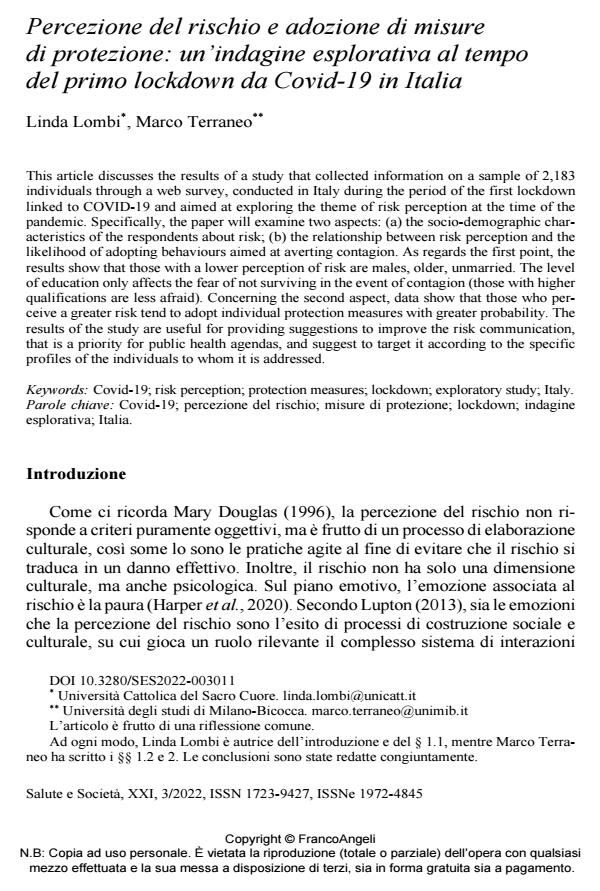Percezione del rischio e adozione di misure di protezione: un’indagine esplorativa al tempo del primo lockdown da Covid-19 in Italia
Titolo Rivista SALUTE E SOCIETÀ
Autori/Curatori Linda Lombi, Marco Terraneo
Anno di pubblicazione 2022 Fascicolo 2022/3
Lingua Italiano Numero pagine 16 P. 154-169 Dimensione file 239 KB
DOI 10.3280/SES2022-003011
Il DOI è il codice a barre della proprietà intellettuale: per saperne di più
clicca qui
Qui sotto puoi vedere in anteprima la prima pagina di questo articolo.
Se questo articolo ti interessa, lo puoi acquistare (e scaricare in formato pdf) seguendo le facili indicazioni per acquistare il download credit. Acquista Download Credits per scaricare questo Articolo in formato PDF

FrancoAngeli è membro della Publishers International Linking Association, Inc (PILA)associazione indipendente e non profit per facilitare (attraverso i servizi tecnologici implementati da CrossRef.org) l’accesso degli studiosi ai contenuti digitali nelle pubblicazioni professionali e scientifiche
This article discusses the results of a study that collected information on a sample of 2,183 individuals through a web survey, conducted in Italy during the period of the first lockdown linked to COVID-19 and aimed at exploring the theme of risk perception at the time of the pandemic. Specifically, the paper will examine two aspects: (a) the socio-demographic charac-teristics of the respondents about risk; (b) the relationship between risk perception and the likelihood of adopting behaviours aimed at averting contagion.As regards the first point, the results show that those with a lower perception of risk are males, older, unmarried. The level of education only affects the fear of not surviving in the event of contagion (those with higher qualifications are less afraid). Concerning the second aspect, data show that those who per-ceive a greater risk tend to adopt individual protection measures with greater probability. The results of the study are useful for providing suggestions to improve the risk communication, that is a priority for public health agendas, and suggest to target it according to the specific profiles of the individuals to whom it is addressed.
Parole chiave:Covid-19; percezione del rischio; misure di protezione; lockdown; indagine esplorativa; Italia.
- Balog-Way D.H.P., McComas K.A. (2020). Covid-19: Reflections on trust, tradeoffs, and preparedness. Journal of Risk Research, 23(7-8): 838-848. DOI: 10.1080/13669877.2020.175819
- Bish A., Michie S. (2010). Demographic and attitudinal determinants of protective behaviours during a pandemic: a review. Br J Health Psychology, 15(4): 797-824. DOI: 10.1348/135910710X48582
- Brickman Bhutta C. (2012). Not by the book: Facebook as a sampling frame. Sociological Methods & Research 41(1): 57-88. DOI: 10.1177/004912411244079
- Cori L., Bianchi F., Cadum E., Anthonj C. (2020). Risk Perception and Covid-19. Int. J. Environ. Res. Public Health, 17, 3114.
- Douglas M. (1996). Rischio e colpa, Bologna: il Mulino [Ed. orig.: (1992), Risk and Blame. Essays in Cultural Theory, London, Routledge].
- Gerhold L. (2020). Covid-19: Risk perception and Coping strategies, PsyArXiv.- Testo disponibile al sito: https://psyarxiv.com/xmpk4 (14/05/2021).
- Giarelli G. (2020). The Governance of Resilience. How the Health Systems Have Coped with The Covid-19 Pandemic. Culture e Studi del Sociale, 5(1): 245-257, Special issue.
- Harper C.A., Satchell L.P., Fido D., Latzman R.D. (2020). Functional Fear Predicts Public Health Compliance in the Covid-19 Pandemic. International journal of mental health and addiction, 1-14.
- Kohler U. (2019). Possible Uses of Nonprobability Sampling for the Social Sciences. Survey Methods: Insights from the Field, 1-12. DOI: 10.13094/SMIF-2019-0001
- Laires P.A., Dias S., Gama A., Moniz M., Pedro A.R., Soares P., Aguiar P., Nunes C. (2021). The Association Between Chronic Disease and Serious Covid-19 Outcomes and Its Influence on Risk Perception: Survey Study and Database Analysis, JMIR Public Health Surveill, 7(1): e22794. DOI: 10.2196/2279
- Lovari A. (2020). Spreading (dis)trust. Covid-19 misinformation and government intervention in Italy. Media and Communication, 8(2): 458-461.
- Lovari A., D'Ambrosi L., Bowen S.A. (2020). Re-connecting voices. The (new) strategic role of public sector communication after the Covid-19 crisis. Partecipazione e Conflitto, 13(2): 970-989.
- Lupton D. (2013). Risk and emotion: towards an alternative theoretical perspective. Health, Risk & Society, 15(8): 634-647. DOI: 10.1080/13698575.2013.84884
- Malecki K.M., Keating J.A., Safdar N. (2021). Crisis communication and public perception of Covid-19 risk in the era of social media. Clinical Infectious Diseases, 72(4): 697-702.
- Mauss M. (2002). Saggio sul dono. Torino: Einaudi.
- Plohl N., Musil B. (2020). Modeling compliance with Covid-19 prevention guidelines: The critical role of trust in science. Psychology, Health & Medicine, 26(1): 1-12. DOI: 10.1080/13548506.2020.177298
- Rana I.A., Bhatti S.S., Aslam A.B., Jamshed A., Ahmad J., Shah A.A. (2021). Covid-19 risk perception and coping mechanisms: Does gender make a difference? International Journal of Disaster Risk Reduction, 55: 102096.
- Rodriguez-Besteiro S., Tornero-Aguilera J.F., Fernández-Lucas J., Clemente-Suárez V.J. (2021). Gender Differences in the Covid-19 Pandemic Risk Perception, Psychology and Behaviors of Spanish University Students. International Journal of Environmental Research and Public Health, 18(8): 3908.
- Wise T., Zbozinek T.D., Michelini G., Hagan C.C., Mobbs D. (2020). Changes in risk perception and self-reported protective behaviour during the first week of the Covid-19 pandemic in the United States. Royal Society open science, 7(9): 200742.
Linda Lombi, Marco Terraneo, Percezione del rischio e adozione di misure di protezione: un’indagine esplorativa al tempo del primo lockdown da Covid-19 in Italia in "SALUTE E SOCIETÀ" 3/2022, pp 154-169, DOI: 10.3280/SES2022-003011